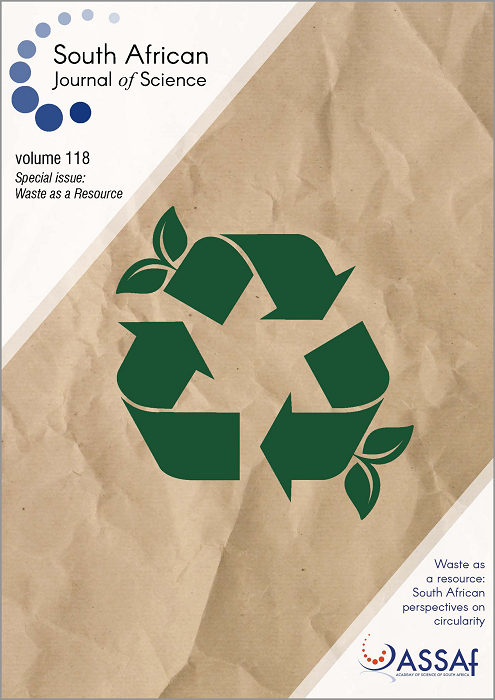Waste characterisation in Stellenbosch Local Municipality, South Africa
DOI:
https://doi.org/10.17159/sajs.2022/12795Keywords:
waste characterisation studies, waste beneficiation, waste data, household solid waste, correlation analysis, waste generation rateAbstract
This article demonstrates how household solid waste (HSW) generation patterns differ in neighbourhoods of the same town by determining the composition of the residual portion of the HSW stream in 2017 in Stellenbosch. HSW was collected from 10 pre-identified suburbs out of a total of 48. These chosen suburbs and their 17 830 households were representative of all the HSW from all households in the catchment area of the Devon Valley Landfill Site. A separation at source programme was in place in nine of the suburbs.The confidence level and level of precision were set at 95% and ±8%, respectively. A total of 1543 bags of HSW were collected with a total mass of 5748.01 kg and an uncompacted volume of 84.87 m3. The samples were sorted into 7 main and 18 final fractions. The main contributor to the total waste stream was organic waste by weight (35%) and plastic wrap and packaging by uncompacted volume (32%). The average HSW generation was 0.68 kg/capita/day. Households with access to a separation at source programme tended to have lower levels of highly recyclable materials in their samples. Roll-out of a separation programme is recommended for all 48 suburbs in the study area to save landfill airspace. Correlation analysis showed that household size influenced three of the seven main waste fractions, and household income five of the seven. No statistically significant results were obtained relating to household density and waste generation. Statistically significant results were obtained through an analysis of variance for all waste fractions, excluding organics, when considering household income, indicating that both household size and income could be explanatory socio-economic factors for variations seen. Other variables, such as human behaviour, could potentially also contribute to the differences and should be further explored.
Significance:
- The availability of reliable waste composition data is not only a contribution to the solid waste management field, but also to any related fields interested in beneficiating or recovering waste. Thesedata are often unavailable, but form the basis for decision-making processes when addressing solid waste (and related) challenges.
Published
Versions
- 2022-09-07 (2)
- 2022-08-31 (1)
Issue
Section
License

All articles are published under a Creative Commons Attribution 4.0 International Licence
Copyright is retained by the authors. Readers are welcome to reproduce, share and adapt the content without permission provided the source is attributed.
Disclaimer: The publisher and editors accept no responsibility for statements made by the authors
How to Cite
- Abstract 735
- PDF 97
- EPUB 319
- XML 28












.png)